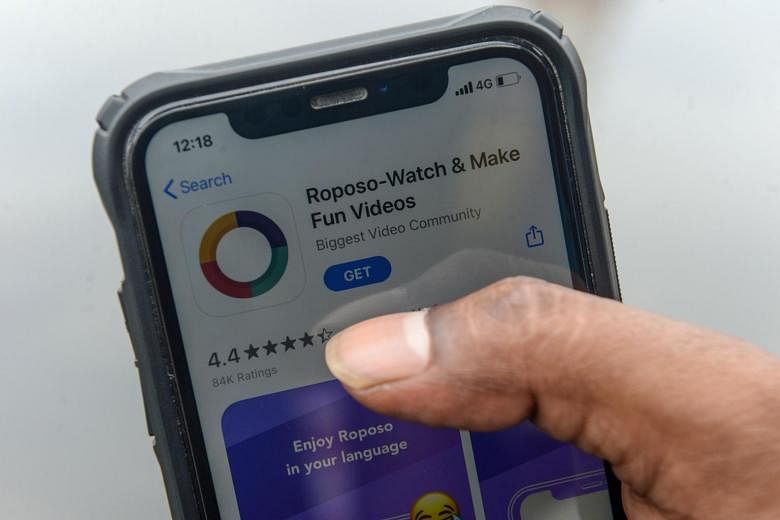NEW DELHI - An assortment of Indian video-sharing apps are competing to take over the commanding position that TikTok enjoyed in the country until it was banned in June.
More than 200 million Indian users of the wildly popular Chinese app, as well as other new users have since been scouring for the right alternative, ratcheting up dizzying growth for Indian video-sharing apps that were little known before to the ban.
There are more than 10 major apps in the reckoning, all counting on a surge in techno-nationalism for their rise against other foreign competitors such as Instagram Reels and the United States-based Dubsmash.
One of the Indian front-runners is Roposo, which brands itself as "India ka apna video app" ("India's own video app"). It has seen monthly active users rise from 15 million in June to 60 million last month.
The arrival of millions of new users was a windfall that some apps were not even ready to accommodate.
Mr Sumit Ghosh, CEO and co-founder of Chingari, another Indian contender, said the day after the ban its service registered 600,000 downloads every hour.
"The whole team was up for the whole 48 hours (following the ban) trying to keep up with the users," he told The Straits Times.
"Now obviously we have scaled up and stabilised"
Firms have had to ramp up staff levels.
The engineering team at Chingari, for instance, has doubled from seven to 14.
Indian apps have also begun spending money to maintain the influx of users as well as retain existing ones.
"Those are the two big challenges and those two are the biggest elements in terms of the efforts that a company puts in," said Mr Bikash Chowdhury, the chief marketing officer for Glance, which owns Roposo.
-
Some of the Indian frontrunners to replace Tiktok
-
Roposo
Roposo was founded in 2014 and acquired by Glance last November. Monthly active users have risen from 15 million in June to 60 million last month. It has more than 90 million downloads, up from 50 million prior to the ban.Chingari
Launched in 2018, it has gone from 3.5 million downloads before the ban to more than 26 million now while daily active users have shot up from half a million to three million. It was named the winner of the government "AatmaNirbhar" Bharat ("Self-reliant" India) App Innovation Challenge in the social category on Aug 7.Mitron
Mitro was launched in April this year. Daily active users have increased from one million to four million while downloads have nearly trebled from 12 million to 33 million.Trell
Founded in 2017, it has notched up five million daily active users from one million before the ban. Downloads have increased from 40 million to 75 million.
The app is trying to retain users by giving them "coins".
Each user gets a few for their first video and earns more subsequently based on how well their videos perform.
These coins can be redeemed on Paytm, an Indian digital wallet.
Users are minting as much as 100,000 rupees (S$1,834) a month on the platform through these coins.
Chingari, on the other hand, announced a countrywide talent contest on July 15 with a 10 million-rupee (S$183,908) top prize as well as 500,000 rupees for each state-level winner.
The firm expects participation from more than 10 million creators.
"We feel we have a very short window of three to six months to fill this void that TikTok has left," added Mr Ghosh, referring to a possibility that TikTok could return if it meets the Indian government's conditions and recoup its users.
The need for deep pockets as apps capitalise on their growth has pushed start-ups to seek out funding while avoiding Chinese money.
Chingari announced this week that it had received seed funding of US$1.3 million (S$1.78 million) from Indian and American investors while Mitron raised 20 million rupees recently.
Mitron CEO and founder Shivank Agarwal told The Straits Times that the Indian market is big enough for players to grow beyond TikTok's core base that catered to young users focused on humour.
The smartphone user base in India is expected to grow from 500 million to 900 million by 2023.
"The good thing was that we were growing rapidly even when TikTok was already there," he said, adding there are opportunities in smaller cities and towns as well as in the age segment beyond 40.
How-to videos, he told ST, could be one such category for the app's expansion.
But Mr Tarun Pathak, an associate director with Counterpoint Research, said the game to replace TikTok is about who pulls in most influencers and how users react to an app's features.
TikTok was especially popular for its ability to recommend videos matching user's preferences and its easy-to-use editing tools.
"Creation of an app that can match TikTok will be very difficult over a small amount of time, especially for start-ups," he noted.
The ease of using TikTok is what Ms Geetha Sridhar misses most.
Ms Sridhar was widely followed for her recipes and tips on how to live well and had a million followers on the Chinese app.
She has tried some of the Indian alternatives but they have left her unimpressed.
She has grudgingly settled for an account on Rizzle, an Indian-American app.
"No one can beat TikTok," Ms Sridhar, 54, told the Straits Times.
"It's my day, my lover, my boyfriend."
And like any faithful lover, Ms Sridhar awaits the day when TikTok may return. "I still have 60 videos saved as drafts," she said.


